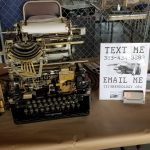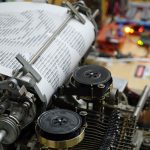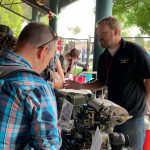Early last year after having a bit of time dedicated to building some USB to TTY interfaces, writing scripts to turn teletypes into email/SMS/art terminals, and doing some minor restoration work on the machines themselves, I noticed that there was going to be a Mini Maker Faire in Salt Lake City again, and I thought to myself, I thought, “Self– these teletypes would probably be the coolest things there if you brought them.” The rest is history, and it’s written below complete with pictures of the exhibition, including the aftermath and a lot of… beforemath.
Note that this post doesn’t go into much detail as to how I built the interface or how I programmed it. That will have to be saved for another time. It may comfort you to know that the interface isn’t nearly done yet; it’s still basically in an alpha state.
Making the world know
To advertise for the Faire, I created a short video. Why don’t you give it a good watch?:
The music is a cover of a piece from one of the last truly worthwhile films made this decade, Interstellar, used with permission from the highly talented people at Grissini Project.
My only real regret of the video is that I made it specific to the date of the 2018 faire, meaning I can’t really use the video again for future Salt Lake Faires. Alas.
The video out of the way, I still had a lot of work to do: only one of the two USB interfaces had been built, there was plenty of programming to complete for the SMS and art modules as well as power control, and there was a lot of wiring to complete for the Pi to be able to control and distribute power to the current loops and teletype motors. It was a somewhat formidable project in retrospect, and the funny thing is that it’s hardly complete even now.
Beforemath
There was a fair amount of work done before I entered the Faire. I also did get plenty of work done over the course of the next few weeks, but it was not enough. I took the day off of work the Friday before the Faire and worked all day and all night until about 6:00 AM to get everything working the way it needed to work. I have vivid memories of finishing scripting the power control modules at some unholy hour only to move on to writing the art module almost completely from scratch.
Unfortunately I didn’t have time to replace the data lines on my Model 19. One of the cables installed by the previous owner had a cut in it when I received it, which I haphazardly fixed with some thin hookup wire and wire nuts. It was meant to be a very temporary solution, but even though I already ordered the replacement old style nylon cable and quarter-inch plugs, I failed to actually replace them in time. It added a nice ghetto flair. The existing cables were also very short, so I was forced to keep the machines all very close together. Eventually these would be replaced by cables over ten feet long, but not in time for the Faire.
Some stupid things happened in the days leading up to and on that day, namely accidentally forgetting a crucial resistor in my current loop circuit when testing, which nearly fried the selector magnets on my Model 15 and which actually fried the transmitting optoisolator used in one of the USB interfaces due to passing an unholy current through it (over 200ma when it was only rated for about 100ma; the selector magnets are supposed to operate at 60ma). Luckily I had one spare optoisolator on hand, which I swapped out to save the day.
At this time I was introduced to Ra-Elco Electronics when I needed some resistors and fuses I didn’t have on hand, and in less than 24 hours. Boy, do I wish I had found them years ago even before Radio Shack went bankrupt twice. Their building sadly burned down later in the year (probably with lots of magic blue smoke), but instead of rebuilding they have bought out another, bigger electronics shop nearby, which I’m excited to visit.
Here’s a video taken at around one o’clock in the morning before the Faire (which was to begin by 10:00 AM) depicting both machines printing art as well as the general mayhem of the situation. The space I had in that basement was small, informal, and not at all conducive to the kind of work I needed to do. We’re thankfully going to be moving into a bigger space soon where I will end up having a more dedicated workspace.
Probably at around two or three o’clock in the morning, I was printing out some more art after oiling and greasing some parts of the Model 15 that I had not heretofore done, and suddenly it started printing out gobbeldegook. Here I was, less than seven hours away from the event for which I had been preparing and dead tired, and one of my machines was giving up the ghost. Or so it seemed.
I was not a very happy person at this point, but when presented with a problem in extenuating circumstances I am not wont to give up but rather dig my heels in to the same extent that fate combines against me. It turns out that the problem went away after letting the machine rest for a while: the next picture of Bugs Bunny or whatever it was I printed next came out fine once the machine had a breather. I would be plagued by this issue again after running the machine for a few hours nonstop throughout the Faire, however, and it is a sign that I really needed to do a thorough cleaning in solution to get the 40+ year-old oil out of the main shaft and other parts. Considering the machines had sat in someone’s basement in Wisconsin for over 40 years, they were in very good shape.
With the Model 19, I printed out a long banner I had created custom for the occasion depicting large letters: KNOW YOUR ROOTS. It probably took an hour or more to print the entire thing, which was a good four or five feet of printing. When I start printing again, I intend to start timing how long each piece of art takes.
I also tried a particularly exquisite piece of Benjamin Franklin:
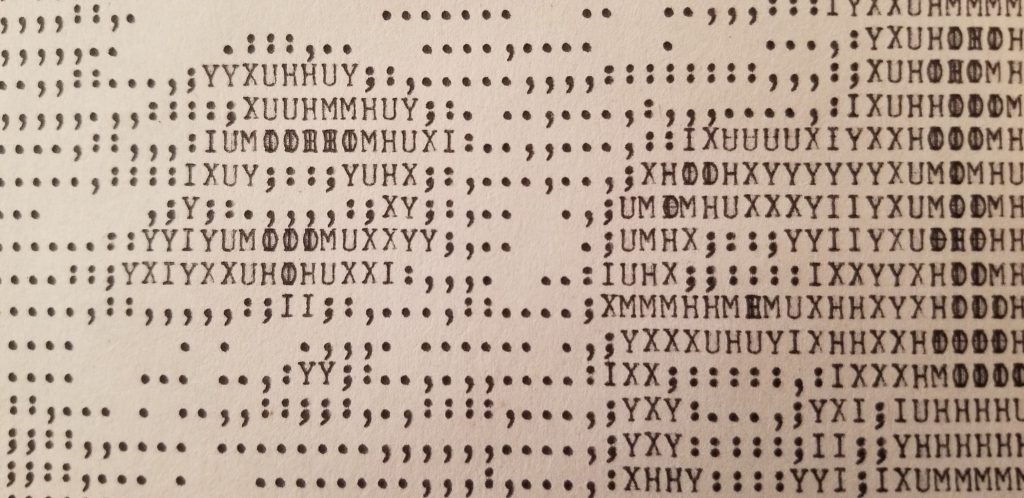
Benjamin Franklin’s eyes printed in ASCII (technically ITA2 or Baudot-Murray) art. You may need to hold this at arm’s length to see the eyes as this is a small close-up of the entire piece, which is over a foot long with overstrike printing on many lines (overstriking is when the teletype prints on the same line twice to make different shapes and darker shades, as you can see above). This one probably took 45 minutes to an hour to print.
The day arrives
Finally at 6:00 AM I let the machines print out the last couple pieces of art and lay myself down to rest, only to wake up an hour or two later to don my custom embroidered Teletype Corporation polo, load the machines all up into the faithful Jeep, and wend my way to the old fairgrounds in Salt Lake City. This would be the first time I went back there since I was a wee lad at the State Fair when I bought a wooden flute for a dollar from the same guy who sold necklaces to Kevin in Home Alone 2.
Long story short, I got all ~200 pounds of equipment into my little booth, said hello to the home automation guys in the booth next to me (another bit I am interested in, though I seem to be the only person on earth who turns his nose up at wireless automation), and set it all up.
Behold, the humble display (sans a few signs– this was from the end of the Faire after I started cleaning up):
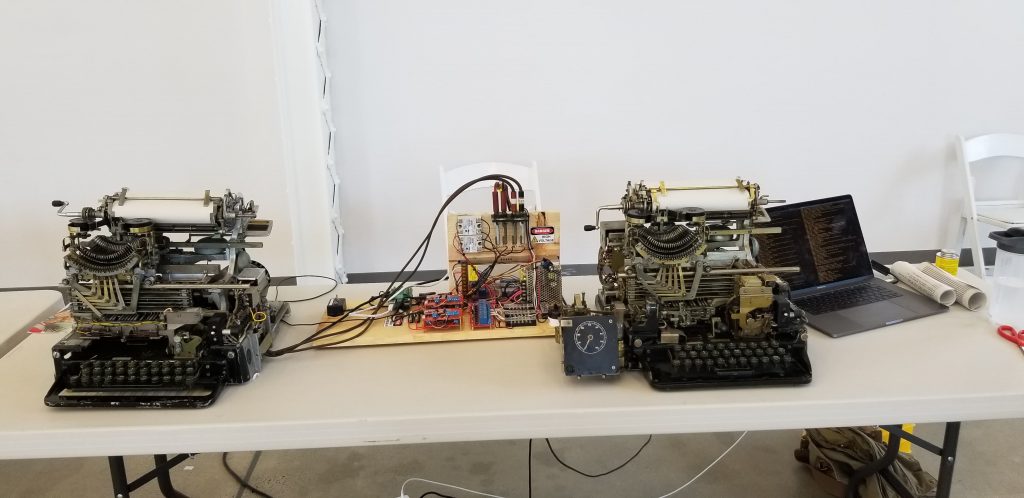
Left: Teletype Model 15 (labeled TG-7-A for U.S. military use). Center: teletype interface/power distributor/controller (I should come up with a fanciful name for this). Right: Teletype Model 19 (labeled TT-7/FG for U.S. military use). Far right: 2017 Macbook Pro– the piece of hardware I hate the most in this array, also possibly the least reliable. The Macbook is not required for operation and was only used to display interesting logs from the Raspberry Pi.
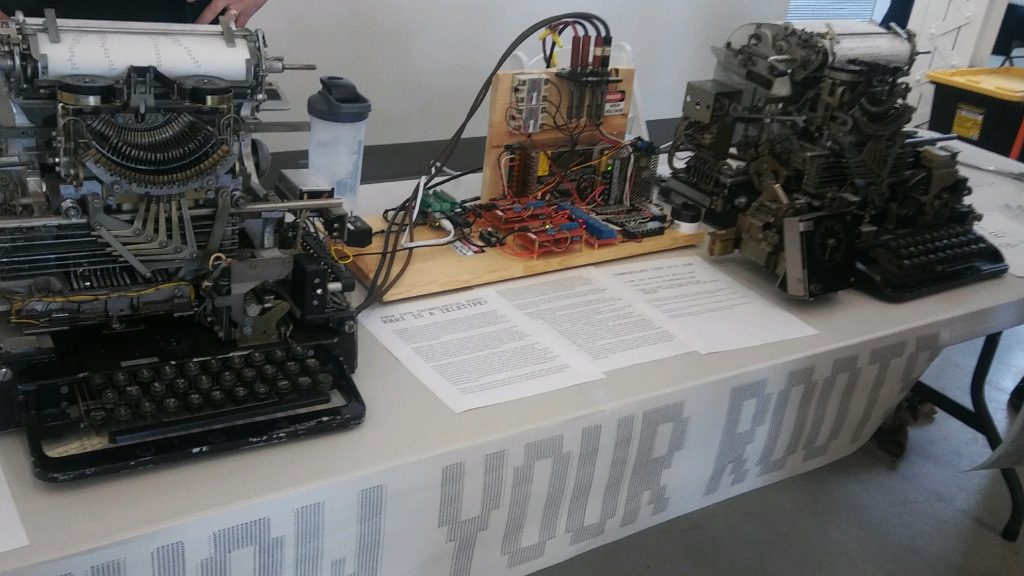
Another view of the teletype display, this time before I removed the signs
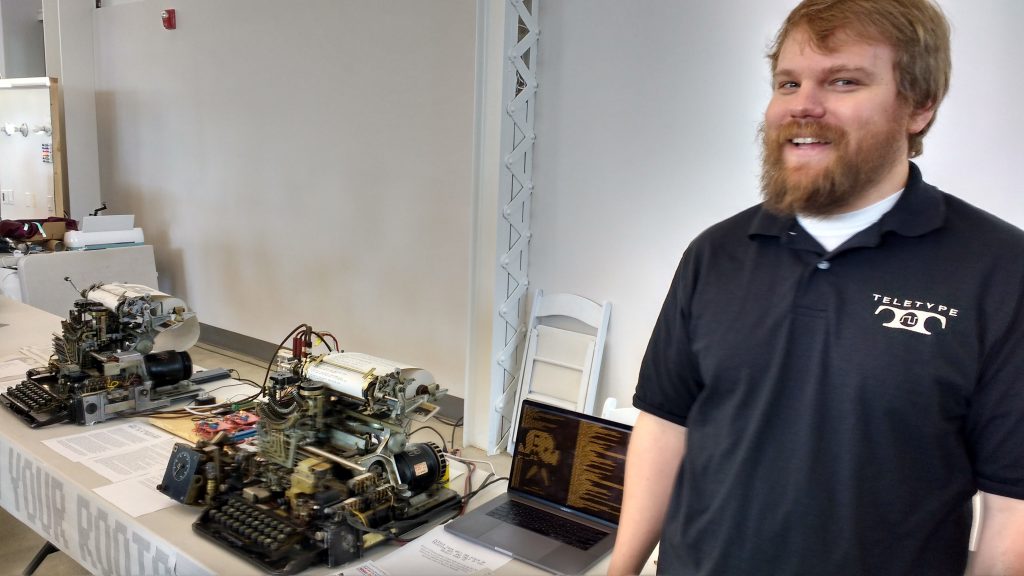
Yet another view, this time with my ugly mug within the viewing angle. Note the custom Teletype Corp polo– a cherished relic of mine.
Joining forces
Another teletype aficionado, John Whitney, also showed up with his Model 33. He had his own home-brewed interface connected to a Linux box and had it connected up to the terminal there, printing out from various programs. I only had a brief few minutes to talk with him and look at his setup, but the machine was in pristine condition, and it was good to make a new friend of his caliber. We were set up across the way from each other, so visitors were able to see the two generations of printers close together.
The pied printer
The moment I sent the first test SMS that morning before the gates officially opened, other booth attendants were attracted by the rhythmic clarion call of my chattering printers, who started coming in droves. I didn’t have a chance to see any of the other booths because mine was already inundated with visitors. This continued up until the gates opened and actual guests started to arrive. Not a shabby start to the day.
Crowds of both young and old enjoyed the machines tremendously. The day flew by with countless SMS messages being printed on the Model 19 and countless art pieces being printed on the Model 15. There were even a few emails printed from some fellow Greenkeys members. I explained their functions to curious people over and over again, and while my voice grew very tired throughout the day, my soul did not. I wish I could do this more often.
Many people thought that I had made heavy upgrades to regular typewriters, and some still wouldn’t believe me when I said the machines were entirely original with the design dating from 1930– I heard people say to their kids several times that they were “typewriters– like the one grandma has”. Not quite.
There were a few people who knew exactly what the machines were and told stories about when they or one of their dads used teletypes for their line of work back in the good old days. I believe one lady specifically knew her dad worked for Western Union. This kind of reminiscing is one of the best parts.
Many people got a kick out of using their phones to record the machine typing out the text message they just sent or the piece of art they requested. There were few people who merely passed by with hardly a glance.
There were a few people who were interested in how everything worked, some coming from a programming perspective, some coming from a mechanical engineering perspective, and some coming from an electrical engineering perspective. It’s always fun to explain the ins and outs, especially when you can tell that the person is actually interested in how the text is translated into baudot, how the serial binary signal on the current loop works, or how the teletype picks up the signal with electromagnets and uses electromechanical magic to select and print out each character. Those who I could tell were bored of the discussion I sent on their way without going into depth. Don’t ask questions to which you don’t want the answers.
Many of the kids were particularly excited by the art printing, and some could hardly wait for their custom orders to complete. One girl said she would hang her picture of Lucy of Peanuts fame up above the light switch in her room. Some kept coming back for more, and I unfortunately had to turn them away since I only had so much in stock I had printed beforehand; at 45 baud, I can only print out new pieces at a pace much more slowly than the laser printers to which they are accustomed. This assumes, of course, that they’ve even seen anything in print outside of a tablet screen before. This also creates a scarcity of sorts, making the pieces all the more valuable.
Individual encounters
There was a gray-bearded electrical engineer whose demeanor hinted of a very well-rounded individual– the kind of person who just had to be wealthy due to intelligence and charisma but who was also very down to earth with a strong character– the kind of person you’d want to be a friend or ally. He found the machines fascinating and told me I had done some really fine work (I needed to explain to him that I didn’t design the two interface boards, so the genius of the core of the electrical bit belongs to a certain Eric Volpe who originally designed them). Even though I didn’t know the man from Adam, it was perhaps one of the comments that has stuck with me the best.
One jokester sent text messages containing rm -rf / and sudo rm -rf /. Nice try, buster. (“sudo rm -rf /” is a Linux command that would in theory erase everything on a computer’s disk, but destroying the Raspberry Pi via SMS simply isn’t possible).
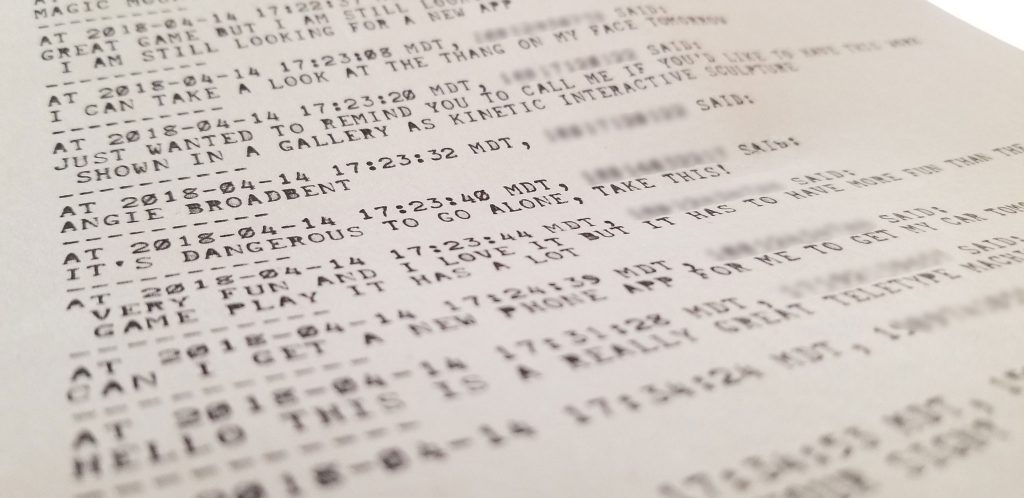
Text messages printed via teletype. You’ll notice the spots in the counters of some of the letters like A, B, P, and R are filled in with ink. This means I still need to use a toothpick and clean out the 40+ year-old gunk from the type slugs– one of the things I never got around to doing before the Faire.
One lady– an artist, I took her to be– said I ought to set them up in an art gallery and offered her services to help make it happen. I just may take her up on that one day– possibly something along the lines of original telegrams or news/war bulletins reprinted live to commemorate those who lived and died in World War II– or something like that. There are a lot of ways I could go with this, a lot of themes I might take.
Privacy sins
I remember one person in particular because he had that condescending air that is all too common amongst those who consider themselves of the techie elite. You know the kind: they act as if everyone else is an idiot– that he or she is the true pinnacle of intelligence simply because he or she has written a bash script. It’s a sort of complex that plagues the IT world almost as badly as horrible communication plagues the IT world. The essence of the complex is that the perpetrator feels less threatened if he or she lowers or puts down everyone else around him or her. If everyone else is reduced, he or she is remains the alpha. The trick is simply not to play the game– not allow them control– and that drives them nuts.
Well, this fellow analyzed the setup, pushed his glasses up his nose, and pointed out the obvious with a snooty grin on his face as if he had just discovered something that would earn him a fat bonus at work:
“You’re printing out people’s phone numbers,” he said.
I rolled my eyes in my heart but kept my composure on the surface. “Oh?”
“It’s a privacy violation,” he said, still grinning in that pathetic way, apparently overjoyed that he could find something he considered a design flaw (“Phew! A close one!” his inner social status trackers must have been saying as they high-fived each other– as social status trackers do).
“It’s on purpose,” I told him bluntly and let the bloke go on his merry way.
The fact of the matter is that I considered that very concern and almost obfuscated the phone numbers in my programming. I decided against it, however, because:
- The phone number is not preserved on the paper for literally anyone in the world to view forever, contrary to the typical postings on the internet.
- Most people already have sold their souls to Facebook, Amazon, and Google. Why not to me?
- Most importantly, vast swaths of people enjoy taking pictures or videos of the silly little things they wrote with the phone number just above it to prove it was they who wrote it. They do not wish to remain anonymous.
Yes, the security engineer within me wants to obfuscate the phone numbers, and I may end up doing it one day, but for now they remain. So calm the heck down.
Success
Ultimately the Faire was a great success not only for me but for many of the other makers who brought their wares. There were an inordinate number of people who came, and most of them made for great visitors to my little teletype booth.
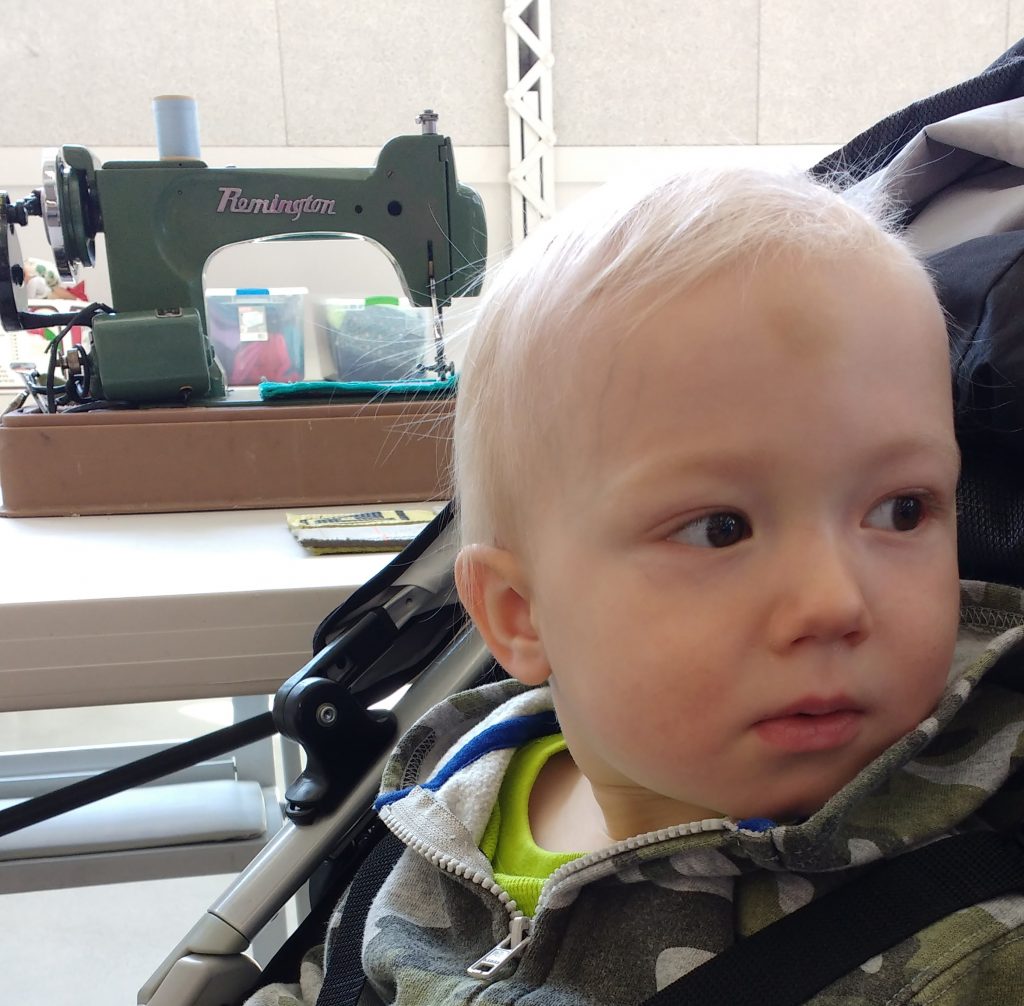
Remington, one of my favorite people, poses in front of a namesake sewing machine somewhere else at the Faire
Documentaries from others’ perspectives
I had meant to take more pictures and videos of my own, but as I had tethered my phone to provide a wired internet connection for the Raspberry Pi, I didn’t have a lot of leeway on that tether for the purpose (yes, I could have set the phone and Pi up to use WiFi instead, but wireless connections are notorious for failing during demos, so I prefer to keep as many legs of the data journey as possible across a physical connection).
There are some videos below from visitors to the Faire with brief clips of the machines in action. Give them a good watch and enjoy. I’ve embedded each video so that they will play starting at the segment where the teletypes are featured, but you ought to watch each one in their entireties if you have time.
This one up above also features John Whitney who also had a machine there, his beautiful Model 33
Aftermath
Afterwards, I was also asked to take part in a brief interview put on by the organizers of the Faire. Here it is.
There were a couple bugs in particular that I didn’t catch, namely that on excessively long emails or SMS messages, the motor and loop supply would cut out a few characters before the message finished. Another issue was that if a command to print art was incorrectly typed, a new prompt wouldn’t be printed until the machine shut itself off some 30 seconds later. Considering the fact that I finally wired everything up and wrote big portions of the code just hours before the event, it could have been a lot worse, and neither bug was very noticeable by the masses.
Stay tuned to read about my escapades in the 2018 Thanksgiving Point Mini Maker Faire that took place later that year as well as future updates about events to which I take my machines, further restoration and programming efforts, and more.
